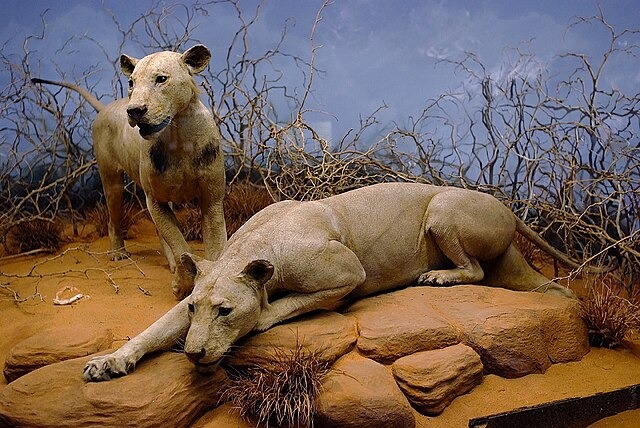The story of the Man-Eaters of Tsavo is one of the most famous and terrifying wildlife tales in Kenya’s history. In 1898, two lions terrorized workers building the Kenya-Uganda Railway near the Tsavo River, in what is now Tsavo National Park.
These lions were notorious for their unusual behavior of hunting humans, and their reign of terror left a lasting legacy in the region.
Background of the Incident
In March 1898, the British colonial government was constructing a bridge over the Tsavo River as part of the railway line connecting Mombasa to Uganda.
The project, vital for trade and transport, required thousands of workers, many of whom were brought from India. The workforce was led by Lt. Colonel John Henry Patterson, a British engineer.
For nine long months, two male lions, both notably without manes (a characteristic of Tsavo lions), began systematically attacking and killing the railway workers. The lions would stalk the camps at night, dragging workers from their tents and devouring them.
Despite building thorn fences—known as bomas—around the camps to keep the lions out, the predators continued their attacks, undeterred. The terror was so overwhelming that many workers abandoned the project, bringing railway construction to a halt.

The Lions’ Reign of Terror
The estimated death toll from the lions’ attacks ranges between 30 to 135 workers, with different sources offering varying numbers. While some accounts might have been exaggerated, there is no doubt that the lions killed a significant number of people.
What made the attacks even more terrifying was the pair’s calculated hunting strategy, where one lion would act as a decoy while the other attacked.
This shocking behavior puzzled many. Unlike typical lions that prey on wild animals, these two had developed a taste for human flesh. Various theories emerged to explain their unusual behavior. One hypothesis is that their normal prey was scarce, forcing the lions to turn to humans for sustenance.
Colonel Patterson’s Hunt
As the attacks continued, Lt. Colonel Patterson took on the responsibility of tracking and killing the lions. Armed with a rifle, he set traps and kept vigil for nights in hopes of ending the nightmare. The hunt was grueling, as the lions proved to be both cunning and elusive.
In December 1898, after a prolonged standoff, Patterson successfully shot and killed the first lion following a tense night-long stakeout. The second lion met its fate a few weeks later, marking the end of their terror.

Theories Behind the Lions’ Behavior
The unusual behavior of the Tsavo lions has fascinated researchers for years, leading to various theories:
- Dental Problems: Studies of the lions’ skulls later revealed that one lion had severe dental disease, including a broken canine. This may have made hunting traditional prey difficult, prompting it to turn to easier, slower-moving human targets.
- Scavenging on Corpses: During the railway construction, many workers died from disease, accidents, and exhaustion. In some cases, their bodies were left unburied, giving the lions easy access to human remains. Some researchers believe the lions may have initially scavenged on these bodies, eventually developing a preference for human flesh.
- Behavioral Peculiarity: Tsavo lions are known for certain unique behaviors, such as living in smaller prides and exhibiting more aggressive tendencies compared to other lion populations. This could have played a role in the boldness of the man-eaters.
Legacy and Impact
The terrifying tale of the Tsavo man-eaters left a profound impact on both the local population and the British colonial administration.
Despite the horror, the construction of the railway bridge was completed, with the railway itself becoming famously known as the “Lunatic Express”, due to the extreme dangers and challenges encountered during its construction.
Colonel Patterson preserved the lions’ skins and skulls as trophies. Today, these relics are displayed at the Field Museum of Natural History in Chicago, USA, where they continue to capture the imaginations of visitors from around the world.
The legend of the man-eaters has inspired numerous books, documentaries, and even a Hollywood adaptation, “The Ghost and the Darkness” (1996), starring Val Kilmer and Michael Douglas. The film dramatizes Patterson’s harrowing hunt for the lions, further cementing the story’s place in popular culture.
Today, Tsavo National Park, one of Kenya’s largest wildlife reserves, is a destination for travelers eager to explore the very grounds where this incredible story unfolded. The Tsavo lions remain a subject of fascination for wildlife enthusiasts and researchers alike, their legacy forever intertwined with the mystique of the African wilderness.

